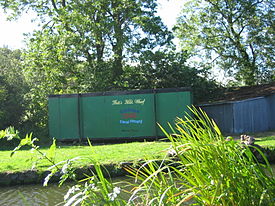Winchburgh
| Winchburgh | |
| West Lothian | |
|---|---|
 Winchburgh, viewed from the south | |
| Location | |
| Grid reference: | NT086750 |
| Location: | 55°57’35"N, 3°27’51"W |
| Data | |
| Post town: | Broxburn |
| Postcode: | EH52 |
| Dialling code: | 01506 |
| Local Government | |
| Council: | West Lothian |
| Parliamentary constituency: |
Livingston |
Winchburgh is a village in West Lothian, six miles east of Linlithgow and three miles northeast of Broxburn. Edinburgh city centre is ten miles to the east.
The mainline railway between Edinburgh and Glasgow Queen Street goes through the Winchburgh Tunnel, under the village. Until it was closed in 1930, there was a passenger station at the north end of the tunnel. The construction of the Winchburgh Tunnel was supervised by the noted civil engineer, John Gibb.
Sport
- Bowling: Winchburgh Bowling Club, established in 1913 by local miners. The clubhouse has a 150-capacity function room for social occasions.
- Football (junior): Winchburgh Albion
Golf: Niddrie Castle Golf Club (18-holes, 5,914 yards long, par 70). It is located in and around the grounds of the historic Niddry Castle. The club was established in 1926.
About the village
There is a small number of convenience store sized shops, a pharmacy, a doctor's surgery, a post office and a Community Centre.
Housing ranges from late-19th Century brick built cottages (purpose-built to house miners and their families) to modern social housing in the forms of houses, cottages and flats. There is also sheltered housing for elderly residents, as well as an elderly care home within the village.

Winchburgh and the Union Canal
The Edinburgh to Falkirk Union Canal passes through Winchburgh. It follows a contour south to Broxburn and eventually Edinburgh. Westwards it goes through Linlithgow, and then Falkirk.
The Union Canal was used in the past to transport goods between places situated in and between Edinburgh and Glasgow - there was a connection with the Forth and Clyde Canal at Falkirk. The Bridge 19-40 Canal Society has a base at Winchburgh on the canal, and it operates seasonal boat trips departing from Port Buchan (in neighbouring Broxburn on West Main Street).
History
There has been a settlement in Winchburgh for over one thousand years. Early spellings include Wincelburgh (1189); Wynchburghe (1377); from the Old English 'wincel' and 'burh' meaning 'Town in the nook or angle'. Its possible it was named after the bend in the Niddry Burn that runs through the village. The early settlement was probably near to Niddry Castle.
After the Battle of Bannockburn in 1314, Sir James Douglas followed King Edward II and the remnants of his army to Winchburgh. Both sides rested at Winchburgh before riding on to Dunbar, where King Edward took ship for England.
Quhill that the king and his menye
To Wenchburg all cummyn ar.
Than lychtyt all that thai war
To bayt thar hors that wer wery,
And Douglas and his cumpany
Baytyt alsua besid thaim ner.—Extract from The Brus by John Barbour (1320-1395), Book 13, written c.1375
In 1568, Mary, Queen of Scots, escaped from Loch Leven Castle, and was met by Lord Seton, before crossing the Firth of Forth from South Queensferry. Mary stayed at Niddry Castle, Seton's property in Winchburgh, on 2 May 1568.

In the 19th century, Winchburgh had a thriving oil shale mining industry, the remnants of which are the distinctive red "shale bings", large hill forms, created by the deposition composed of used shale. The bings support a variety of flora and fauna, such as bushes and heather, rabbits and, occasionally, old deer. The bings are also known locally as "tips", although it is a generally less common name for them.
On 13 October 1862 on the Edinburgh and Glasgow Railway a mile and a half northwest of Winchburgh was the scene of a head-on rail crash in which 15 people were killed.[1]
In the Ordnance Gazetteer of Scotland (1892–1896), Winchburgh is described:
Winchburgh, a village in Kirkliston Parish, Linlithgowshire, 11¾ miles W of Edinburgh. It has a station on the North British Railway, a Post Office with money order and savings bank departments, an Established mission church (opened 1891) and a public school. Pop. (1881) 115, (1891) 424.[2]
The early 21st century has seen the construction of several new private housing estates on the periphery of the village, with the potential the double the population of the village.
Outside links
| ("Wikimedia Commons" has material about Winchburgh) |
- Winchburgh Church
- Winchburgh to Linlithgow - images on the Union Canal
- Niddry Castle